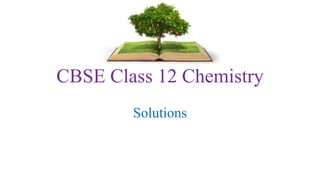
CBSE Class 12 Chemistry Chapter 2 (Solutions) | Homi Institute
- 1. CBSE Class 12 Chemistry Solutions
- 5. Molal mass Molal mass Solubility of a solid in a liquid The solubility of a solid in a liquid is significantly affected by temperature changes. Pressure does not have any significant effect on solubility of solids in liquids.
- 6. Here 𝑲𝑯 is the Henry’s law constant
- 7. Solubility of gases increases with decrease of temperature. It is due to this reason that aquatic species are more comfortable in cold waters rather than in warm waters.
- 8. According to Dalton’s law of partial pressures, the total pressure (𝑝𝑡𝑜𝑡𝑎𝑙) over the solution phase in the container will be the sum of the partial pressures of the components of the solution and is given as: Conclusions Total vapour pressure over the solution can be related to the mole fraction of any one component. Total vapour pressure over the solution varies linearly with the mole fraction of component 2. Depending on the vapour pressures of the pure components 1 and 2, total vapour pressure over the solution decreases or increases with the increase of the mole fraction of component 1.
- 9. Volatile - that can change suddenly and unexpectedly. In chemistry, volatility is a material quality which describes how readily a substance vapourises. In at a given temperature and pressure, a substance with high volatility is more likely to exist as a vapour, while a substance with low volatility is more likely to be a liquid or solid.
- 10. Vapour Pressure of Solutions of Solids in Liquids In a pure liquid the entire surface is occupied by the molecules of the liquid. If a non-volatile solute is added to a solvent to give a solution, the vapour pressure of the solution is solely from the solvent alone. This vapour pressure of the solution at a given temperature is found to be lower than the vapour pressure of the pure solvent at the same temperature.
- 11. Liquid-liquid solutions can be classified into ideal and non-ideal solutions on the basis of Raoult’s law. The solutions which obey Raoult’s law over the entire range of concentration are known as ideal solutions. The ideal solutions have two other important properties. The enthalpy of mixing of the pure components to form the solution and the volume of mixing is always zero.
- 12. In Ideal Solution - No heat is absorbed or evolved when the components are mixed. Also, the volume of solution would be equal to the sum of volumes of the two components. At molecular level, ideal behaviour of the solutions can be explained by considering two components A and B. In pure components, the intermolecular attractive interactions will be of types A-A and B-B, whereas in the binary solutions in addition to these two interactions, A-B type of interactions will also be present. If the intermolecular attractive forces between the A-A and B-B are nearly equal to those between A-B, this leads to the formation of ideal solution. A perfectly ideal solution is rare but some solutions are nearly ideal in behaviour. Solution of (n-hexane and n- heptane), (bromoethane and chloroethane), (benzene and toluene), etc. fall into this category.
- 13. Acetone and Carbon disulphide form binary liquid solution showing positive deviation from Raoult's law. When Acetone and Chloroform are mixed together hydrogen bonds are formed between them which increases intermolecular interactions hence decreases the vapour pressure showing negative deviation from Raoult’s law. <
- 15. Minimum-boiling or Positive azeotrope Maximum-boiling or Negative azeotrope
- 20. Fig - The vapour pressure curve for solution lies below the curve for pure water. The diagram shows that Δ𝑇𝑏denotes the elevation of boiling point of a solvent in solution.
- 24. Ethanoic acid also called Acetic acid ( CH3COOH) associate in solution to form a dimer due to hydrogen bonding. NaCl dissociate into two ions when dissolved in water.
